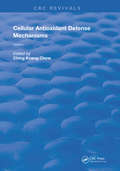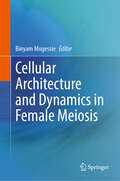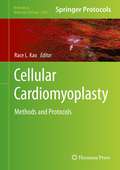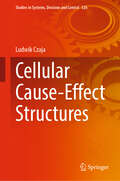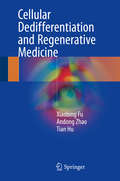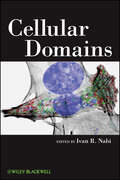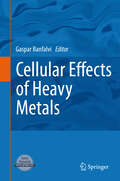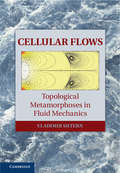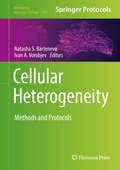- Table View
- List View
Cells and Heredity
by David Sadava H. Craig Heller Gordon H. Orians William K. Purves David M. HillisTextbook.
Cells and Heredity: Module B Grades 6-8 (2018 Edition) (HMH Science Dimensions)
by Marjorie Frank Michael R. Heithaus Michael A. DiSpezioNIMAC-sourced textbook
Cells in Evolutionary Biology: Translating Genotypes into Phenotypes - Past, Present, Future (Evolutionary Cell Biology)
by Brian K. Hall Sally A. MoodyThis book is the first in a projected series on Evolutionary Cell Biology, the intent of which is to demonstrate the essential role of cellular mechanisms in transforming the genotype into the phenotype by transforming gene activity into evolutionary change in morphology. This book —Cells in Evolutionary Biology — evaluates the evolution of cells themselves and the role cells have been viewed to play as agents of change at other levels of biological organization. Chapters explore Darwin’s use of cells in his theory of evolution and how Weismann’s theory of the separation of germ plasm from body cells brought cells to center stage in understanding how acquired changes to cells within generations are not passed on to future generations. The study of evolution through the analysis of cell lineages during embryonic development dominated evolutionary cell biology until usurped by the switch to genes as the agents of heredity in the first decades of the 20th century. Discovery that cells exchanged organelles via symbiosis led to a fundamental reevaluation of prokaryotic and eukaryotic cells and to a reorganizations of the Tree of Life. Identification of cellular signaling centers, of mechanisms responsible for cellular patterning, and of cell behavior and cellular condensations as mediating the plasticity that enables phenotypic change during evolution, provided powerful new synergies between cell biology and evolutionary theory and the basis for Evolutionary Cell Biology. Key Selling Features: Summarizes the long history of the essential role of cells in evolutionary change. Demonstrates that cellular processes transform genetic change into phenotypic change in development and in evolution. Documents the evidence that cells provide the missing mechanistic link between the genotype and the phenotype in evolutionary theory. Illustrates the necessity of integrating cell biology into evolutionary theory.
Cells to Civilizations: The Principles of Change That Shape Life
by Enrico CoenThe science of change from cells to cultureCells to Civilizations is the first unified account of how life transforms itself—from the production of bacteria to the emergence of complex civilizations. What are the connections between evolving microbes, an egg that develops into an infant, and a child who learns to walk and talk? Award-winning scientist Enrico Coen synthesizes the growth of living systems and creative processes, and he reveals that the four great life transformations—evolution, development, learning, and human culture—while typically understood separately, actually all revolve around shared core principles and manifest the same fundamental recipe. Coen blends provocative discussion, the latest scientific research, and colorful examples to demonstrate the links between these critical stages in the history of life.Coen tells a story rich with genes, embryos, neurons, and fascinating discoveries. He examines the development of the zebra, the adaptations of seaweed, the cave paintings of Lascaux, and the formulations of Alan Turing. He explores how dogs make predictions, how weeds tell the time of day, and how our brains distinguish a Modigliani from a Rembrandt. Locating commonalities in important findings, Coen gives readers a deeper understanding of key transformations and provides a bold portrait for how science both frames and is framed by human culture.A compelling investigation into the relationships between our biological past and cultural progress, Cells to Civilizations presents a remarkable story of living change.
Cellular Ageing and Replicative Senescence (Healthy Ageing and Longevity #4)
by Suresh I. S. Rattan Leonard HayflickThis book covers the origins and subsequent history of research results in which attempts have been made to clarify issues related to cellular ageing, senescence, and age-related pathologies including cancer. Cellular Ageing and Replicative Senescence revisits more than fifty-five years of research based on the discovery that cultured normal cells are mortal and the interpretation that this phenomenon is associated with the origins of ageing. The mortality of normal cells and the immortality of cancer cells were also reported to have in vivo counterparts. Thus began the field of cytogerontology. Cellular Ageing and Replicative Senescence is organized into five sections: history and origins; serial passaging and progressive ageing; cell cycle arrest and senescence; system modulation; and recapitulation and future expectations. These issues are discussed by leading thinkers and researchers in biogerontology and cytogerontology. This collection of articles provides state-of-the-art information, and will encourage students, teachers, health care professionals and others interested in the biology of ageing to explore the fascinating and challenging question of why and how our cells age, and what can and cannot be done about it.
Cellular Antioxidant Defense Mechanisms (Routledge Revivals #1)
by Ching Kuang ChowFirst Published in 1988, this three volume set offers a full insight into the immune system and its response to antioxidants. Carefully compiled and filled with diagrams, references and information this set is recommended for students of immunology and other professionals in their respective fields.
Cellular Antioxidant Defense Mechanisms (Routledge Revivals #2)
by Ching Kuang ChowFirst Published in 1988, this three-volume set offers a full insight into the immune systems and its response to antioxidants. Carefully compiled and filled with diagrams, references and information this set is recommended for students of immunology and other professionals in their respective fields.
Cellular Antioxidant Defense Mechanisms (Routledge Revivals #3)
by Ching Kuang ChowFirst Published in 1988, this three-volume set offers a full insight into the immune systems and its response to antioxidants. Carefully compiled and filled with diagrams, references and information this set is recommended for students of immunology and other professionals in their respective fields.
Cellular Architecture and Dynamics in Female Meiosis
by Binyam MogessieThis book brings together a diverse and exciting group of emerging and leading experts in female meiosis, each contributing a chapter that summarizes seminal recent progresses in their area of specialty. With various meiosis topics ranging from cytoskeletal function in worms to studies of oocyte meiosis in large mammals, this collection is intended for fundamental cell biologists interested the basic mechanisms of cell division and differentiation.
Cellular Aspects of Wood Formation (Plant Cell Monographs #20)
by Jörg FrommWith today's ever growing economic and ecological problems, wood as a raw material takes on increasing significance as the most important renewable source of energy and as industrial feedstock for numerous products. Its chemical and anatomical structure and the excellent properties that result allow wood to be processed into the most diverse products; from logs to furniture and veneers, and from wood chippings to wooden composites and paper. The aim of this book is to review advances in research on the cellular aspects of cambial growth and wood formation in trees over recent decades. The book is divided into two major parts. The first part covers the basic process of wood biosynthesis, focusing on five major steps that are involved in this process: cell division, cell expansion, secondary cell wall formation, programmed cell death and heartwood formation. The second part of the book deals with the regulation of wood formation by endogenous and exogenous factors. On the endogenous level the emphasis is placed on two aspects: control of wood formation by phytohormones and by molecular mechanisms. Apart from endogenous factors, various exogenous effects (such as climate factors) are involved in wood formation. Due to modern microscopic as well as molecular techniques, the understanding of wood formation has progressed significantly over the last decade. Emphasizing the cellular aspects, this book first gives an overview of the basic process of wood formation, before it focuses on factors involved in the regulation of this process.
Cellular Awakening: How Your Body Holds And Creates Light
by Barbara WrenWhat if almost everything you’ve been told about health and the human body is wrong? What if you had within you the ability to heal from any condition? This fascinating book by Barbara Wren shatters many of the myths that currently exist regarding health and illness, and presents a vision of the human body and healing that is both practical and inspirational. In essence, no matter what ailment you’re dealing with, you have the potential to heal yourself; and if you already enjoy great health, you can illuminate your consciousness in ways beyond your imagining. Whatever your current situation is, you can begin to feel a true connection to who you really are, as well as understand your ability to create your own reality. Your human potential is far greater than you can possibly imagine and is intrinsically linked to what is unfolding within you at a cellular level. Each and every one of the trillions of cells within your amazing body has the potential to hold and utilize light in the form of bio photons, subatomic particles of light. When a cell is illuminated, the DNA within that cell is also illuminated, giving you access to the universal wisdom that is held within its matrix. By matching your microcosm (the cell) with the macrocosm (the universal energies), you can begin to unlock your true nature and realize your potential for greatness.
Cellular Biology of the Endoplasmic Reticulum (Progress in Molecular and Subcellular Biology #59)
by Marek Michalak Luis B. AgellonThis book provides a comprehensive overview of the biology of the endoplasmic reticulum (ER) and the associated ER proteins, it discusses their structure, function and signaling mechanisms in the cell and their role in disease. This book also offers insights into the practical aspects of research and demonstrates the use of non-mammalian models to study the structure and function of the ER. Written by leading experts in the field, the book enables readers to gain a thorough understanding of current ER biology. It is intended for scientists and clinical researchers working on the endoplasmic reticulum in all its various roles and facets in health and disease.
Cellular Biophysics and Modeling: A Primer on the Computational Biology of Excitable Cells
by Greg Conradi SmithWhat every neuroscientist should know about the mathematical modeling of excitable cells. Combining empirical physiology and nonlinear dynamics, this text provides an introduction to the simulation and modeling of dynamic phenomena in cell biology and neuroscience. It introduces mathematical modeling techniques alongside cellular electrophysiology. Topics include membrane transport and diffusion, the biophysics of excitable membranes, the gating of voltage and ligand-gated ion channels, intracellular calcium signalling, and electrical bursting in neurons and other excitable cell types. It introduces mathematical modeling techniques such as ordinary differential equations, phase plane, and bifurcation analysis of single-compartment neuron models. With analytical and computational problem sets, this book is suitable for life sciences majors, in biology to neuroscience, with one year of calculus, as well as graduate students looking for a primer on membrane excitability and calcium signalling.
Cellular Biophysics, Volume 1: Transport
by Thomas Fischer WeissCellular Biophysics is a quantitatively oriented basic physiology text for senior undergraduate and graduate students in bioengineering, biophysics, physiology, and neuroscience programs. It will also serve as a major reference work for biophysicists. Developed from the author's notes for a course that he has taught at MIT for many years, these books provide a clear and logical explanation of the foundations of cell biophysics, teaching transport and the electrical properties of cells from a combined biological, physical, and engineering viewpoint. Each volume contains introductory chapters that motivate the material and present it in a broad historical context. Important experimental results and methods are described. Theories are derived almost always from first principles so that students develop an understanding of not only the predictions of the theory but also its limitations. Theoretical results are compared carefully with experimental findings and new results appear throughout. There are many time-tested exercises and problems as well as extensive lists of references. The volume on transport is unique in that no other text on this important topic develops it clearly and systematically at the student level. It explains all the principal mechanisms by which matter is transported across cellular membranes and describes the homeostatic mechanisms that allow cells to maintain their concentrations of solutes, their volume, and the potential across the membrane. Chapters are organized by individual transport mechanisms -- diffusion, osmosis, coupled solute and solvent transport, carrier-mediated transport, and ion transport (both passive and active). A final chapter discusses the interplay of all these mechanisms in cellular homeostasis.
Cellular Cardiomyoplasty: Methods and Protocols (Methods in Molecular Biology #1036)
by Race L. KaoEmbryonic stem cells and adult stem cells are the two major types of stem cells that have been used for experimental and clinical studies. Embryonic stem cells are totipotent cells that have the capability to differentiate into any type of cell in the body. In Cellular Cardiomyoplasty: Methods and Protocols, expert researchers in the field detail many of the methods which are now commonly used to study cellular cardiomyoplasty. Methods and techniques described in this volume use only adult stem cells or adult progenitor cells.Written in the highly successful Methods in Molecular Biology series format, chapters include introductions to their respective topics, lists of the necessary materials and reagents, step-by-step, readily reproducible laboratory protocols, and key tips on troubleshooting and avoiding known pitfalls. Authoritative and Practical, Cellular Cardiomyoplasty: Methods and Protocols will benefit the cardiologist, cardiothoracic surgeons, biologist (cell, molecular, or structural), biochemist, and physiologist who are interested in understanding and treating damaged myocardium and failing heart.
Cellular Cause-Effect Structures (Studies in Systems, Decision and Control #526)
by Ludwik CzajaThis book presents the adaptation of cause-effect structures to the formal description of phenomena such as the behaviour of living objects, the mutual communication of living cells, but also such as the growth of crystals and other natural processes. The system of cause-effect structures has been designed for the description and analysis of objects with dispersed components, acting concurrently and synchronizing and communicating one another. This adaptation consists in customizing generic semantics of cause-effect structures to semantics specific to the behaviour of natural objects. That is creating evolution rules for the formal models of these objects. However, the structural, algebraic properties of cause-effect structures are retained. The activity of cellular cause-effect structures is supposed to imitate the activity of cellular automata, the formal system intended for the above-mentioned aims. But operations on syntactic constructions, in particular their transformations and simplification, are the same as for the general cause-effect structures. These algebraic operations are also used to perform certain geometric/topological conversions of location bases for the cellular cause-effect structures, like flat surfaces into cylindrical or toroidal. This is depicted by numerous illustrations. An adaptation of cause-effect structures to other formal descriptions of some natural phenomena, such as reaction systems, is provided in book 331 of the “Lecture Notes in Networks and Systems” series, whereas the complete description of cause-effect structures, in book 45.
Cellular Dedifferentiation and Regenerative Medicine
by Xiaobing Fu Andong Zhao Tian HuThis book focuses on the contribution of cell dedifferentiation to the regenerative process in all body systems, as well as its underlying molecular mechanisms and applications.The book is divided into four parts, the first of which addresses the history of cell dedifferentiation and regenerative medicine. In turn, Part II compares three routes by which cells change their phenotype: dedifferentiation, transdifferentiation, and reprogramming. Part III includes an extensive review of cell dedifferentiation events in all nine body systems for lower organisms and mammalians, respectively. The final part reviews the relationship between cell dedifferentiation and the development of cancer and several other diseases, while also outlining the prospects of and future research directions in cell dedifferentiation and regenerative medicine. The main purpose of the book is to underline the importance of cell dedifferentiation in stem cell and regenerative medicine by providing a systematical review of dedifferentiation in all body systems, together with the latest reliable evidence.
Cellular Dialogues in the Holobiont (Evolutionary Cell Biology)
by Thomas C. G. Bosch Michael G. HadfieldThis book examines how the growing knowledge of the huge range of protist-, animal-, and plant-bacterial interactions, whether in shared ecosystems or intimate symbioses, is fundamentally altering our understanding of biology. The establishment and maintenance of these interactions and their contributions to the health and survival of all partners relies on continuous cell-to-cell communication between them. This dialogue may be concerned with all aspects of the biology of both partners. The book includes chapters devoted to exploring, explaining, and exposing these dialogues across a broad spectrum of plant and animal eukaryotes to a broad field of biologists. Key Features Explores the nature of the interactions between eukaryotic hosts and their microbial symbionts Examines the links between prostist, animal, and plant evolution and microbial communities Reviews specific taxa and the microbial diversity associated with these taxa Illustrates the role microbes play in the physiology and etiology of several model species Includes chapters by an international team of leading scholars
Cellular Domains
by Ivan R. NabiCellular domains play vital roles in a wide range of cellular functions. Defining cellular domains and understanding the molecular basis of their formation is essential to the study of cell functionality. This authoritative reference provides the most comprehensive analysis available on cellular domains, with emphasis on the definition and molecular composition of the domain as well as the functional implications of domain organization.
Cellular Ecophysiology of Microbe: Hydrocarbon and Lipid Interactions
by Tino KrellThis book assembles concisely written chapters by world-leaders in the field summarizing recent advances in understanding microbial responses to hydrocarbons. Subjects treated include mechanisms of sensing, hydrocarbon tolerance and degradation as well as an overview on hydrophobic modification of biomolecules. Other chapters are dedicated to issues related to the reduced bioavailability of hydrocarbons, which differentiates this class of compounds form many others, but which of central importance to understand the ecophysiological consequences. This book should be standard literature in any laboratory working in this area.
Cellular Effects of Heavy Metals
by Gaspar BanfalviThe term "heavy metals" is used as a group name of toxic metals and metalloids (semimetals) causing contaminations and ecotoxicity. In strict chemical sense the density of heavy metals is higher than 5 g/cm3. From biological point of view as microelements they can be divided into two major groups. a. For their physiological function organisms and cells require essential microelements such as iron, chromium (III), cobalt, copper, manganese, molidenium, zinc. b. The other group of heavy metals is toxic to the health or environment. Of highest concern are the emissions of As, Cd, Co, Cu, Hg, Mn, Ni, Pb, Sn, Tl. The toxicity of heavy metals is well known at organizational level, while less attention has been paid to their cellular effects. This book describes the toxicity of heavy metals on microorganisms, yeast, plant and animal cells. Other chapters of the book deal with their genotoxic, mutagenic and carcinogenic effects. The toxicity of several metals touch upon the aspects of environmental hazard, ecosystems and human health. Among the cellular responses of heavy metals irregularities in cellular mechanisms such as gene expression, protein folding, stress signaling pathways are among the most important ones. The final chapters deal with biosensors and removal of heavy metals. As everybody is eating, drinking and exposed to heavy metals on a daily basis, the spirit of the book will attract a wide audience.
Cellular Flows: Topological Metamorphoses in Fluid Mechanics
by Vladimir ShternA cell, whose spatial extent is small compared with a surrounding flow, can develop inside a vortex. Such cells, often referred to as vortex breakdown bubbles, provide stable and clean flame in combustion chambers; they also reduce the lift force of delta wings. This book analyzes cells in slow and fast, one- and two-fluid flows and describes the mechanisms of cell generation: (a) minimal energy dissipation, (b) competing forces, (c) jet entrainment, and (d) swirl decay. The book explains the vortex breakdown appearance, discusses its features, and indicates means of its control. Written in acceptable, non-math-heavy format, it stands to be a useful learning tool for engineers working with combustion chambers, chemical and biological reactors, and delta-wing designs.
Cellular Heterogeneity: Methods And Protocols (Methods In Molecular Biology #1745)
by Natasha S. Barteneva Ivan A. VorobjevThis volume is essential for anyone struggling with the cellular heterogeneity field, and it connects this new area with the latest advances in innovative techniques combined with practical advice from international experts. The chapters provide a comprehensive overview of cellular heterogeneity analysis techniques, exploring cytometry, imaging and spectroscopy methods, metabolic and molecular biological methods in tracking, as well as chromatin and cell cycle heterogeneity. Written in the highly successful Methods in Molecular Biology series format, chapters include introductions to their respective topics, detailed lists of the necessary materials and reagents, step-by-step, readily reproducible laboratory protocols, and key tips on troubleshooting and avoiding known pitfalls. Authoritative and accessible, Cellular Heterogeneity: Methods and Protocols encourages readers to explore new ways of studying cells that will help lead to exciting new discoveries.
Cellular Imaging: Electron Tomography and Related Techniques (Biological and Medical Physics, Biomedical Engineering)
by Eric HanssenThis book highlights important techniques for cellular imaging and covers the basics and applications of electron tomography and related techniques. In addition, it considers practical aspects and broadens the technological focus by incorporating techniques that are only now becoming accessible (e. g. block face imaging). The first part of the book describes the electron microscopy 3D technique available to scientists around the world, allowing them to characterize organelles, cells and tissues. The major emphasis is on new technologies like scanning transmission electron microscopy (STEM) tomography, though the book also reviews some of the more proven technologies like electron tomography. In turn, the second part is dedicated to the reconstruction of data sets, signal improvement and interpretation
Cellular Lipid Metabolism
by Christian EhnholmFor years lipids have fascinated cell biologists and biochemists due to their profound effects on cell function. "Cellular Lipid Metabolism" highlights new concepts and recent findings, but also reviews important discoveries made in the past. Outstanding international experts contribute 13 chapters on the genetics, molecular and cell biology of lipids. Presenting analyses at the molecular level they reveal the principles by which cellular lipid metabolism functions. Further, numerous intriguing observations that cannot yet be explained are identified, stimulating the readers to future studies. This book provides an invaluable source of information for biomedical researchers in energy metabolism, vascular biology, endocrinology and lipidology.





